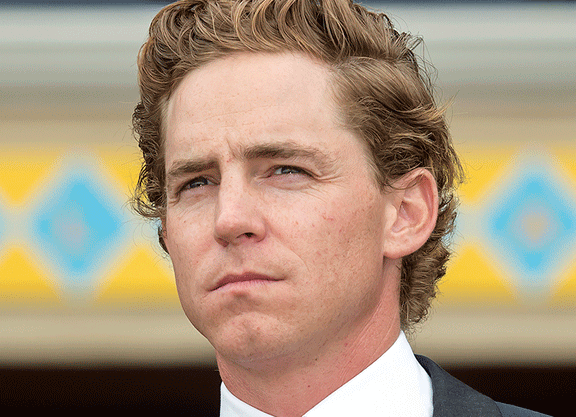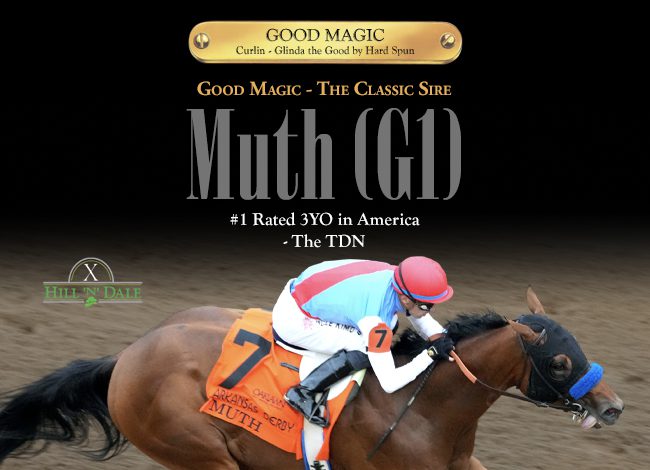By Dan Ross
It was a trip that did it. Stopped the clock. Sealed the deal. Shot Cupid's arrow straight through the left ventricle.
“It was a real life-changing experience, because, at the time, I was already really falling in love with American racing, and the whole industry here,” says Santa Anita-based trainer Dan Blacker, about a journey he took with his Darley Flying Start cohorts to the USA. The venue? Churchill Downs, that first Saturday in May, the year the ill-fated and unbeaten Barbaro did the honours in the style of a legend he would later become.
For a young Brit nourished on the bucolic tranquility of Oxfordshire's hills and dales, the mad bacchanal of Kentucky Derby day hit him with the force of a blunt trauma injury.
“It just blew me away,” he says. The carnival theatrics. “The intensity.” The sense of occasion. “The passion of the people who worked in the industry.” It wasn't just one thing–it was the whole gestalt.
“America's the land of opportunity,” he says, about a certain takeaway from that trip, which would be confirmed in spades over the years to come. “I felt like I would have opportunities here that I wouldn't have back home.”
If Blacker, 35, sounds like a born-again who's proselytizing on behalf of the American consulate, that's because he has good reason to. Since taking out his trainer's licence in California, he's steadily grown the firepower in his stable, which began with three horses in 2011. No mean feat, especially during a time when racetracks in the state have been shuttered and finances rocky. Last year, he posted by far his best season yet, with 13 winners and over $500,000 in earnings.
What's more, numbers on the home front have been steadily growing, too. Blacker married TVG host Christina Olivares in 2012, and they have three young daughters: Margo, four, Violet, two, and Eliza, a weanling.
“I started with nothing, and I think Americans are very open to giving young people a chance, whereas back home, it's much harder. You need more backing, a big name behind you,” says Blacker. “Here, if you're passionate, and you show you can win races, people will give you a shot. It doesn't matter where you're from, what your last name is, if you're winning, people are going to give you a shot. That's what I love most about America.”
What's intriguing, however, is to compare the certainty and conviction of the 2018 Blacker with the uncertainty and ambivalence of the younger version.
His father is world-renowned equine sculptor Philip Blacker, who, prior to picking up the rasp and riffler was an accomplished jump jockey–he of Pollardstown fame (winner of the 1979 Triumph Hurdle). There was no helicopter parenting with Philip. The young Blacker messed around with horses, did a bit of showjumping, helped out at trainer Nicky Henderson's stable.
“But my father never encouraged me to go into racing,” he says. Instead, Blacker eventually found himself, with the encouragement of a teacher, attending Edinburgh University, pursuing a degree in environmental geoscience. What could he do with that? Oil and gas exploration was one possible path. But it was during his time at Edinburgh that the roots of Blacker's actual career were dug and planted.
For a bit of spare cash, Blacker formed one third of an unholy trinity of students from Edinburgh–which included Sam Waley-Cohen (future Cheltenham Gold Cup-winning amateur jump jockey), and Ed Sackville (future bloodstock agent)–who rode out for nearby trainer Peter Monteith. “They were good times,” he recalls.
Back then, “I wasn't really sure I wanted to be a trainer,” he admits. But he was able to appreciate the unusual alchemy of Monteith's outfit, noted for sweetening the soured outcasts from other stables–in particular, those horses owner David Johnson would shift from Martin Pipe's conveyor belt of winners. “We'd get these horses that would come in three-legged, and he would really just nurse them back,” says Blacker.
Monteith was a “great trainer, great horseman,” he says. And the horses, “when they got to the races they were so tough. We would gallop around this ploughed field, and they'd be knee-deep in a bog. Gallop up a hill that was 45 degrees. And they'd get turned out in a huge paddock all day and night to run around.”
In 2010, Monteith took his own life. “It's just so sad that he was so miserable inside. He's another example of someone you'd least suspect. He was always so happy, really positive.” Indeed, Blacker credits Monteith with being “so influential” in his decision to eventually train–a decision that found another gear when Blacker was accepted into the Darley Flying Start programme, in 2005.
“Flying Start, that was a major turning point in my life, from not being totally sure what I wanted to do to being totally sure,” he states.
Blacker speaks in epochs. The life-changing culture shock of the Kentucky Derby. Monteith's reform school for equine misfits that turned him away from oil and gas back towards hay, oats and saddle soap. The flying start given to him by Flying Start. When Blacker spent, as part of that programme, three months with the California-based, Hall of Fame-inducted Gandalf of the training game, Richard Mandella, “that's when I fell in love with California, and Californian racing,” he says.
After Mandella, Blacker spent time with, among others, Australian trainer David Hayes–part of his Flemington string, back when Miss Finland was Queen Bee of Aussie racing (and Winx was a mere twinkle in Street Cry's eye). And in England with Jeremy Noseda, back when Sixties Icon and Fleeting Spirit were winning Group 1 races at both ends of the stamina spectrum. But Blacker couldn't shake the memory of Mandella. And so, when his two-year Flying Start placement was over, like a boomerang he rounded back on Southern California, to Mandella, as assistant.
So, what was it about Mandella that Blacker found so instructive?
“I'd grown up around horses, I felt like I knew horses, and was pretty confident that I really understood horses,” he says. “But when I worked for Mandella, I realised that I had so much more to learn. There was this whole other aspect of horsemanship I didn't know about.” Mandella, Blacker says, is a problem solver. “When he sees a problem, he wants to fix it. I'd like to think that I am partially in that mindset as well.”
He believes a science degree helps with this analytical side of modern training. “I have a lot of conversations with my vet that I don't think I'd be able to unless I have that scientific manner,” says Blacker. “We try and eliminate every variable that could be causing an issue, and approach the problem in a manner that makes sense scientifically.”
Perhaps it's not surprising, then–if you see improvement as commensurate with evolution–that he says he's evolved as a trainer.
“When you start training, you have an idea of how you would like things to work. But you're constantly tweaking the system to improve it. I've probably morphed into a more California-style trainer than when I started, because you've got to do what works, and what produces winners.”
By “California-style trainer,” Blacker means one thing in particular: speed. “California's a really tough place to keep horses sound–tougher than the East Coast, even. The way we train. The speed. It produces winners, but one of the downsides of that is the high attrition rate.”
This helps to explain why Blacker believes America, and California in particular, is a must-do for aspiring trainers looking for a one-stop-shop instruction course. “We train hard here, and consequently we see more problems,” he says. “It really changed the way I think about training. It's a very intensive way of learning.”
Certain horses are more equipped to handle this environment than others, and when Blacker goes shopping in Europe, he carries a wish list for horses that have or like: fast ground, a turn of foot, “nice to see them come from behind,” lightness on feet, and a lighter frame.
He says, “Generally, the big heavy types don't work here. You have to have a good mind. When they come here, it's so intense, if you have a really nervous one over there, it's only going to be more pronounced.”
It would be fair to say, too, that Blacker's own mental equilibrium endured a testing time during his first few years with a licence. He started well, enjoyed a few nice winners, but then, “I maybe rested on my laurels a bit,” he says. “Things slowed down a bit.”
He started hustling for new owners–something he should have done when the winners were easier to come by, he admits. “Trying to get new owners and horses to your barn when you're not really doing well, that's almost impossible.”
But the perseverance has paid off. A turning point was when Brad Kelley's Calumet Farm joined the fold. “When I got a big Kentucky name behind me, I think people saw that, and I think that was the start of the success I enjoyed last year.”
Indeed, Blacker's patron list now includes Spendthrift Farm, Bourbon Lane Stables, and the Melbourne 10 syndicate. Special mention, he says, should go to John Harris, of Harris Farms. “He's probably been my biggest supporter right from the beginning. I probably wouldn't be training today were it not for him.”
And special mention, too, to his wife, Christina: “I know it's a cliché, but she really has been my rock throughout all of this.”
People often ask Blacker whether he intends returning to the UK to train. His response? “My wife's American. My children are basically American. They're going to go to school here. I don't think it's a likely scenario. But, never say never. This business is so fickle.”
He does return home “once or twice a year” for the Tattersalls Horses in Training sales and also for holidays. “I took the family back home for Christmas.” Staying in touch with old friends is a sticky business. “I'm just so busy. I have my children, now. A year goes by, two years, three years. When you're on the racetrack, you never get time to do anything that's considered normal.”
He surfs a bit. Skis even less. Between training and family, there's time for little else. But you get the sense that that's not a terribly big problem–and, when he talks about the effect the California gold-dust has on the European horses that arrive in America, it might, just might, be a subconscious metaphor for the effect it's had on himself.
He says, “When they come over here, they just have this affinity with the way we train. The way we feed. The climate. The track surface. The sunshine. All these things. They just flourish. They go through this transformation and become a better racehorse.”
Not a subscriber? Click here to sign up for the daily PDF or alerts.






